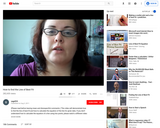
This is an instructional video demonstrating how to plot data to create a scatterplot and then find the correlation and equation of the line of best fit.
- Subject:
- Mathematics
- Material Type:
- Lecture
- Author:
- sage024
- Date Added:
- 12/10/2013
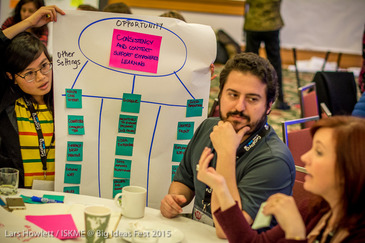

This is an instructional video demonstrating how to plot data to create a scatterplot and then find the correlation and equation of the line of best fit.

Many tests will require you to write a timed essay. You may feel panicked at the idea of having to produce a high-quality essay under a tight time constraint. But you can relax: this video shows you four basic steps to follow so that you can write a great essay quickly.
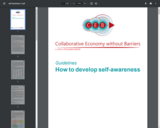
Guidelines about how to structure non formal learning sessions about self-awareness for adult learners with disability: a collection of effective practical exercises.
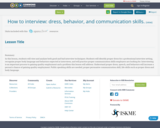
In this lesson, students will view and analyze both good and bad interview techniques. Students will identify proper dress for a professional interview setting, recognize proper body language and behaviors expected at interviews, and will practice proper communication skills employers are looking for. Interviewing is an important process to gaining quality employment and a problem this lesson will address. Understand proper dress, speech, and behaviors will increase a person's chance of gaining quality employment. Public speaking skills are needed, proper persuasive communication skill, life skills such as proper dress and body language.
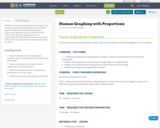
Students will use ratios to demonstrate the connections between proportional relationships, lines, and linear equations. Students will solve problems using a cooperative, kinesthetic activity in which they will create a ratio table, then graph proportional relationships with their bodies to demonstrate that the ratio (or rate) is the slope that will always pass through the origin.
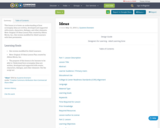
This lesson is to foster an understanding of how screenplay ideas are written, developed and supported with events, characters, dialogue, and other elements.
Note: Original .01 Ideas Lesson Plan created by Albion Movie, Inc.; this version modified for Adult Learners with their permission.

____________________________________________________________________________From Albion Movie, Inc.: "BROUGHT TO YOU BY OUR SPONSOR:Our lesson plans are available at no cost to educators, thanks to the generosity of our education sponsor. Please visit the Bradenton Gulf Islands on Florida’s Gulf Coast". ____________________________________________________________________________This lesson is to foster an understanding of how screenplay ideas are written, developed and supported with events, characters, dialogue, and other elements.Note: Original .01 Ideas Lesson Plan created by Albion Movie, Inc.; this version modified for Adult Learners with their permission. Learner Audience / Primary UsersAdult, 9th-12th grade reading level , non-traditional student working towards achieving a high school diploma Addresses: College & Career Readiness Standards (CCRS) AlignmentLevel: Adult EducationGrade Level: CCRS Grade Level E (9-12 grade reading level)Subject: CCRS English Language Arts Strand: CCRS Writing StrandSub-strand: Writing of Literature, History/Social Studies, or Technical subjectsStandard Description: CCRS description(s) for the specific standard(s) and supporting standard(s) that align with your lesson:CCR Anchor 3: Write narratives to develop real or imagined experiences or events using effective technique, well-chosen details and well-structured event sequences.Prior Knowledge Students must read and write at the 9th grade level; have the ability to navigate the Internet, and type into a Word processor.Lesson Author & License Lesson Author: Suzanne Ensmann (Modified for Adult Ed students; original .01 Ideas Lesson Plan created by Albion Movie, Inc.: "BROUGHT TO YOU BY OUR SPONSOROur lesson plans are available at no cost to educators, thanks to the generosity of our education sponsor. Please visit the Bradenton Gulf Islands on Florida’s Gulf Coast"). License for .01 Ideas Lesson Plan: Creative Commons CC BY 4.0 license
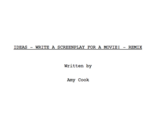
This lesson is to foster an understanding of how screenplay ideas are written, developed and supported with events, characters, dialogue, and other elements within a mobile learning format. Tools and software used in conjunction with this lesson are available on mobile app platforms.

The learner audience for this lesson are adults preparing for the GED, specifically the English/Language Arts portion. The lesson introduces “evidence” as a necessary support for claims in a persuasive essay, or argument. It demonstrates what the relationship between words and ideas in a claim should be to the key ideas in a passage, or passages, cited in support of a claim. Learners practice using evidence to support a claim about the role of motivation and procrastination in their own lives, then find at least one piece of evidence from an article on that topic.
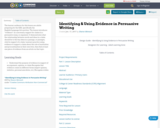
The learner audience for this lesson are adults preparing for the GED, specifically the English/Language Arts portion. The lesson introduces “evidence” as a necessary support for claims in a persuasive essay, or argument. It demonstrates what the relationship between words and ideas in a claim should be to the key ideas in a passage, or passages, cited in support of a claim. Learners practice using evidence to support a claim about the role of motivation and procrastination in their own lives, then find at least one piece of evidence from an article on that topic.
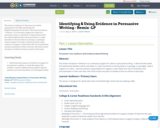
The learner audience for this lesson are adults preparing for the GED, specifically the English/Language Arts portion. The lesson introduces “evidence” as a necessary support for claims in a persuasive essay, or argument. It demonstrates what the relationship between words and ideas in a claim should be to the key ideas in a passage, or passages, cited in support of a claim. Learners practice using evidence to support a claim about the role of motivation and procrastination in their own lives, then find at least one piece of evidence from an article on that topic.
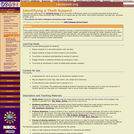
This model-eliciting activity (MEA) challenges students to develop a model for predicting the characteristics of a person who has committed a crime. Students work with real data on shoe length, height, and gender to develop the model. Students write a report to the crime victim that identifies a suspect and justifies their decision. The activity sets the stage for students to learn about regression models, and reinforces their understanding of central tendency and variability. It is suggested that this activity be used prior to a formal introduction to linear relationships.

Inequalities are mathematical statements that connect unequal expressions.
This curriculum guide will help students understand inequalities, and be able to differentiate between inequality signs. They will solve inequality problems, being able to recognize problems where the inequality signs will need to change to arrive at a solution. Students will represent inequality solutions on a number line.

The ratio of a circle's circumference to its diameter is always the same: 3.14159... and on and on (literally!) forever. This irrational number, pi, has an infinite number of digits, so we'll never figure out its exact value no matter how close we seem to get. Reynaldo Lopes explains pi's vast applications to the study of music, financial models, and even the density of the universe.

This infographic is a quick guide to assist users to understand Knowles' Six Assumptions About Adult Learning.This work is licensed under a Creative Commons Attribution-Non Commercial-ShareAlike 4.0 International License.

This course outline examines topics of importance to educators participating in instructional design projects. Topics include needs assessment, adult learning principles, learning objectives, instructional strategies, assessment, implementation and evaluation. Learners will develop a course using media and open educational resources while observing copyright and plagiarism guidelines.

This lesson will be the first of six lessons guiding students in constructing the abstract concepts necessary to understand adding positive and negative integers.
It is designed for adult learners (or middle school or older) who are not fluent with using numbers. A real life lesson will be included in this series of lessons-Budgeting.

For many adult students, positive and negative integers are an example of when math “keeps changing the rules.” This is the fifth of six lessons guiding students in constructing the abstract concepts necessary to understand adding positive and negative integers.
This lesson will review previous knowledge about negative numbers and teach adding integers with different signs. This is a time when it’s important to stress to students that understanding this lesson will help them in many future lessons.

This lesson will be the first of six lessons guiding students in constructing the abstract concepts necessary to understand adding positive and negative integers.
It is designed for adult learners (or middle school or older) who are not fluent with using numbers.
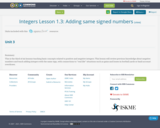
This is the third of six lessons teaching basic concepts related to positive and negative integers. This lesson will review previous knowledge about negative numbers and teach adding integers with the same sign, with connections to “real life” situations such as gains and losses in football yards or bank account overdraws.